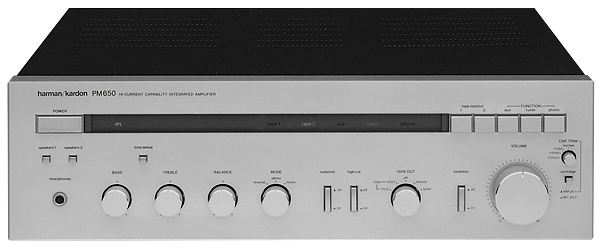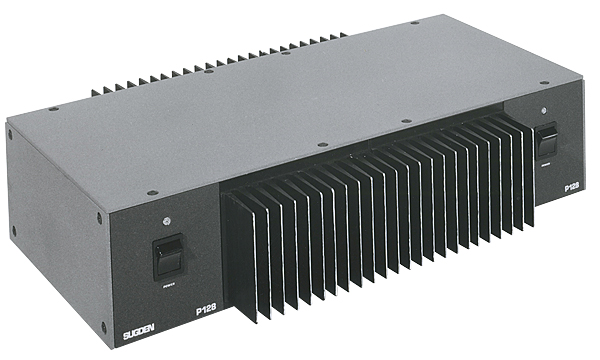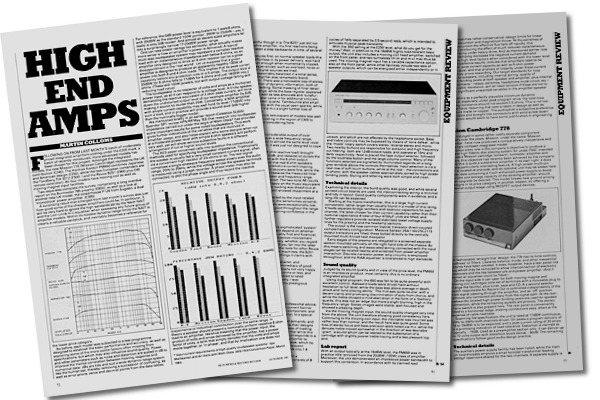High-End Amps Page 2
Via disc (MM) the treble register came in for additional criticism, showing a 'thin' and mildly 'leaden' quality. Tambourine and small bells did not seem to ring properly with the usual open sparkle, while some vocal sibilance was heard. Via MC a slight further loss of expression and detail was noted.
Conclusion
Bluntly, the sound quality here is more reminiscent of models less well equipped and less powerful, but costing in the region of £300 to £400, not the elevated £900 we are considering. For the audiophile I feel the presentation lacks character, and somewhere in its complex stages the life and immediacy of good program material becomes diluted. Personally, I was disappointed with the sound of such an apparently prestigious product.
Harman Kardon PM650
Harman Kardon is firmly flying the high-peak current banner for its new amplifier range. The PM650 forms its key component, and is built in Japan by Silver – part of the parent company – to what is a special set of load-tolerant parameters.

Harman Kardon certainly shows an up-to-date knowledge of reactive load demands, and makes extensive use of comparative data to show how its designs maintain strong voltage-source output level, regardless of loading. Carefully specified, HK has stated in a press release that while this model is rated at a 17dBW (50W 8ohm) level, which corresponds to a peak current of 3.5A, it is possible for the amplifier to sustain its output level up to a maximum of 30A peak, which by HK's data corresponds to the worst dynamic case or transient impedance of a 4ohm-rated speaker (full level of 18dBW into 1.4ohm minimum reactive).
No attempt has been made to supply such currents on a continuous or FTC basis, and the test signal employed consists of eight cycles of 1kHz separated by 0.5 second rests, which is intended to simulate musical peak transients.
With the PM650 selling at the £250 level, what do you get for the money? Well, in addition to the 18dBW highly load-tolerant basic output, the unit also includes an MC head amplifier, switched on the front panel, and two turntables (MM and MC) may thus be used. The MM input has a variable capacitance option, also on the front panel, while other facilities include two sets of loudspeaker outputs, which can be energised either independently or in unison, and which are not affected by the headphone socket.
The amp's bass and treble controls may be bypassed by means of 'tone defeat', while the 'mode' rotary switch covers stereo, reverse stereo and mono. Two nearby buttons are responsible for subsonic and high frequency filtering; both are second-order (12dB/octave) types, and operate at 15Hz and 6kHz respectively. Next to this is placed the tape output selector, followed by the loudness button and the large volume control.
Many of the functions selected are signalled by illuminated legends on a long grey window above the controls themselves. Input selection is via a neat row of soft-touch buttons, while at the rear the connections are in phono, with the speaker cables appropriately joined by high power binding posts. The amp's overall styling and the lettering used were both simple and clean.
![]() Sound Quality
Sound Quality
Judged by its sound quality and price, the PM650 is an impressive product. Most certainly, this is no ordinary integrated amplifier.
Using digital program, the PM650 was felt to be quite powerful with excellent control. Awkward loads were driven hard without hesitation to full level, while the bass was above average in depth, attack and 'tune playing ability'.
The mid was quite neutral, with a decent clarity and promising discrimination of solo from chorus, and while the treble showed a mild aberration in the form of a 'feathery' quality, this was not an 'edge' but more a slight blurring, high in the frequency range. Stereo images were stable, well-focused and showed a pleasing depth.
Conclusion
This is a very worthy product, possessing a competitive sound quality that's open, neutral, and clear. The bass was above average and the amp is clearly rather more powerful than the specification suggests. Moreover, it can sustain that generous level into any good speaker that I know. With its versatile set of facilities, this integrated amplifier is a good all-rounder, and comes well recommended.
Sugden P128
Next up we have a power amplifier. The Yorkshire-based company of JE Sugden has long followed a traditional approach to both amp construction and finish, although with its recent use of a Nextel suede-like coating on all external components, one might be forgiven for thinking that it had modernised its style. However, in the case of the P128 this was not to be, and this product shows only too clearly how important external form is to the visual appeal of a product.

Supplied as a pair of complete, cased monaural amplifiers strapped together under a single detachable top cover, it's hard at first to determine which is the front and which is the back of the unit. Large black finned radiators – usually a feature of a model's rear furniture – are here present both front and back, and one has to look closely for the signal and loudspeaker connectors to determine finally which side is which. A well ventilated cupboard is a good place to locate this model in my opinion.
Performance-wise the spec. indicates that Sugden aims high. Each monoblock is rated at 21dBW into 8ohm, and a continuous 4ohm rating of 170W is also given, which is equivalent to 19dBW. Midband distortion is said to be typically better than –66dB, while both gain and input impedance (300kohm) represent a good match for the direct connection of CD players at a nominal 0.5V (for 20dBW output). The power bandwidth, re. 20dBW output, is specified with –3dB points at 12Hz and 35kHz.
Individually the amplifier blocks are fairly tidy, measuring 10cm tall by 22cm wide and 10cm deep, with Sugden suggesting that they should be located adjacent to the speakers if possible, thus exploiting the virtues of short cable runs.
As for the overall constructional quality of the amplifier, this is perhaps best regarded as being of a good commercial standard, rather than aspiring to the higher semi-professional standards encountered with more costly models.
![]() Sound Quality
Sound Quality
The P128 proved to be an effortless performer in power terms. lt showed good behaviour into clip, maintaining an essentially 'soft' character in the upper frequency range, not too far removed from that of a large valve amplifier. The overall tonal quality was pleasantly balanced with a nice midrange. lt sounded a trifle 'filtered' in the Quad 405-2 mould, and also betrayed a similar 'band limited' effect, as if the frequency response limits were just audible at the band extremes.

On transient performance the bass was felt to suffer from a slight loss of attack, the lowest octaves sounding rich rather than crisp. The mid was clear enough, while the treble, of a pleasant and essentially musical nature, also showed a moderate loss of 'sparkle' and 'openness'. Stereo images were well presented, with a good standard attained as regards depth and focus. The image quality was in fact little removed from our current reference in this price range (the A&R SA200).
The Sugden P128 proved tolerant of more awkward loudspeakers, and hence should give a consistent sound when used in a variety of systems. Maximum sound levels suggested that on program peaks a short-term rating of 24dBW (approx 220W) per channel would be appropriate, making this a very big amplifier for the price.
Conclusion
Costing somewhat under £400, the Sugden P128 has acquitted itself well. Offering a generous power capacity it is one of the largest load- and clip-tolerant power amplifiers in current production.
The sound quality is pretty good too and the amplifier should give long service, representing an obvious choice for more spirited working with a Quad ESL-63 electrostatic for example, while it will also drive most moving-coil speakers well. The P128 clearly represents good value for money and can be recommended.


















































